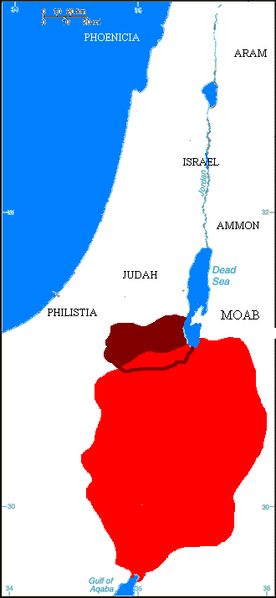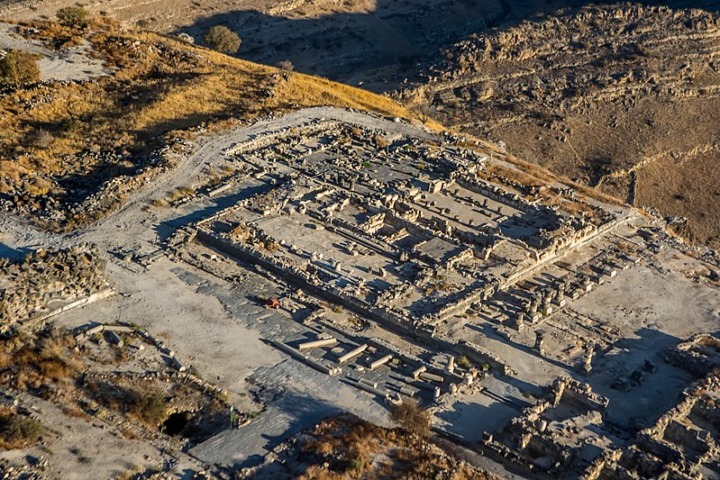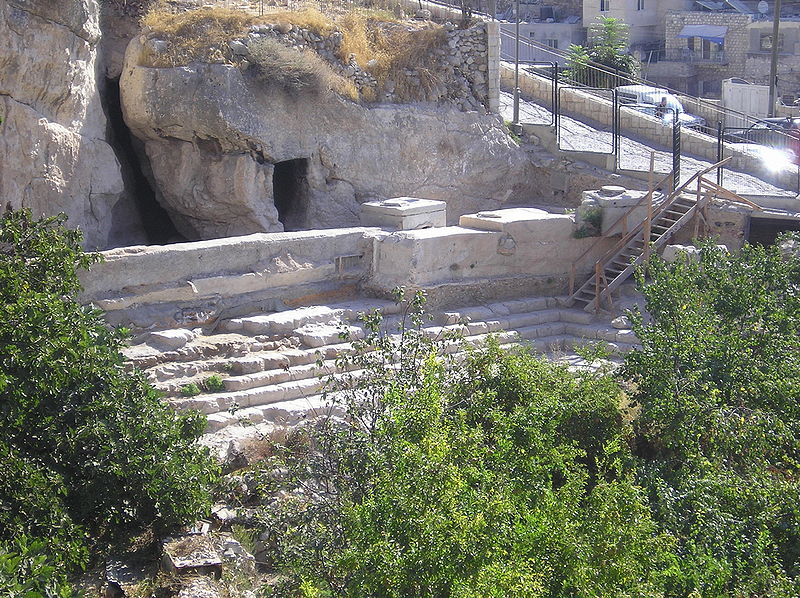2017年5月25日にエルサレム旧市街南部の地下トンネルで発見された「踏み固められた道」で、イスラエル考古学庁とイスラエル自然・公園局の職員は共同作業をしている。現在、この道は一部公開されている。
[toggle]Workers of the Israel Antiquities Authority and the Nature and Parks Authority work at the ”stepped street” in a underground tunnel, outside the southern part of Jerusalem’s Old City, on May 25, 2017. This road is now partially opened for public visitation. [/toggle]ゴリアト(サムエル記上17章でダビデと戦った巨人)ほどの高さがある壁から、爪ほどに小さい封泥(ふうでい)まで、2019年に発表された考古学的発見は、私たちの聖書理解を豊かにしてくれる。
[toggle]From Goliath-size walls to clay seal impressions the size of a fingernail, archaeological discoveries announced in 2019 continued to add context to our understanding of the Bible. [/toggle](聖書の記述を歴史的事実と考えない)考古学者や聖書学者は、考古学が聖書を証明するという考え方に反対する。しかし、多くの主要メディアによってこれらの考古学的発見が報道され、「聖書がすべて正しかった」、あるいは「結局のところ正しかった」と認められた。かつて考古学者のネルソン・グリュックが宣言したように、「考古学上の発見は、聖書にあることと食い違うことはない」のだ。
[toggle]Archaeologists and Bible scholars resist the idea that archaeology proves the Bible. But many of the mainstream media stories announcing these discoveries acknowledged that the Bible was right all along or right after all in these instances. Archaeologist Nelson Glueck’s declaration that “no archaeological discovery has ever controverted a Biblical reference” still stands. [/toggle]注意:このランキングは主観的であり、ニュース・メディアの報道に基づいたものだ。2019年になされた聖書考古学的に最も重要な発見は、それまで何年も知られていなかったが、その年の科学専門の出版物に掲載された。
[toggle]Note: this list is subjective, and is based on news media reports. The most significant discoveries of biblical archaeology made in 2019 may not be known for a number of years, until the work of 2019 is published in peer-reviewed scientific publications. [/toggle]
10位 ペリシテ人の祖先はヨーロッパ人
[toggle]10) Philistines had European ancestry [/toggle]現代のイスラエル南部のアシュケロンにあるペリシテ人の墓で人骨が発掘され、そこから抽出されたDNAにより、ペリシテ人がヨーロッパ人の祖先を持つことが分かった。これによって、長きにわたって信じられていたとおり、また聖書がペリシテ人について述べていることが正しいと証明された。
「ペリシテ人をすべて滅ぼす日が来る。……その日、主はカフトルの島に残っているペリシテ人を滅ぼされる」(エレミヤ47:4)
「私はイスラエルをエジプトの地から、ペリシテ人をカフトルから……導き上ったではないか」(アモス9:7)
上記の聖句ではペリシテ人が「カフトル」と結びつけられているが、それは現在のクレタ島といわれている。かつてミノア文明(エーゲ文明のうちクレタ島における青銅器文明)が栄えた場所だ。DNAの記録から、ペリシテ人がすぐにカナンの地元民と結婚し、遺伝子的特徴が薄くなったことが分かった。
[toggle]DNA extracted from skeletons excavated from burials at the Philistine city of Ashkelon in modern-day Israel showed European ancestry. This confirms what has long been believed and what the Bible says about the Philistines. Jeremiah 47:4 and Amos 9:7 connect the Philistines with Caphtor, which has been identified as Crete, the home of the Minoan civilization. The DNA record shows that the Philistines quickly intermarried with the local population, diluting the genetic signature. [/toggle]
エドム王国(赤)を最大範囲で示す地図(紀元前600年)。
イスラエル南端にあるティムナとヨルダン南部のフェイナンで取れた銅の堆積物のかたまりを調査した考古学者は、3000年も前にエドム人(エサウを先祖とする部族)が、銅を採掘するための高度に整った技術を持っていたことを発見した。そのためエドム王国の成立は、それまでより300年ほど早まり、紀元前11世紀ごろと結論づけられた。「イスラエルの人々を治める王がまだいなかった時代に、エドムの地を治めていた王たちは次のとおりである」(創世36:31)とあるように、イスラエルよりも先にエドムには王がいたのだ(初代のイスラエル王サウルの在位が紀元前1020~1000年とされている)。
[toggle]Archaeologists studying copper slag deposits from Timna in Israel and Faynan in Jordan (two sites south of the Dead Sea) found that Edomites used advanced, standardized techniques more than 3,000 years ago to mine copper. In light of this discovery, they concluded that the Edomite kingdom was formed by the middle of the 11th century BC, about 300 years earlier than previously thought. Genesis 36:31 says there were kings in Edom before there were any Israelite kings. [/toggle]
黄金の祭壇のモデル(写真:Ori229)
8位 祭壇の角
[toggle]8) The horn of an altar [/toggle]長い間、イスラエルの主の幕屋が置かれていたシロにおける発掘で、2019年、「祭壇の角」と思われるものが発見された。「ヨアブは主の天幕に逃げ込み、祭壇の角をつかんだ」(列王上2:28)とある。
[toggle]The 2019 excavation at Tel Shiloh, the site where the Israelite tabernacle stood for several centuries, turned up what appears to be the corner of an altar. The discovery illustrates 1 Kings 2:28: Joab “fled to the tent of the Lord and took hold of the horns of the altar.” [/toggle]
テル・エ・サフィの発掘現場(写真:Ori~)
7位 ガトにあるゴリアトの壁
[toggle]7) Goliath wall at Gath [/toggle]テル・エ・サフィ(ペリシテ人の町ガトと同定されている)における2019年の発掘作業で、紀元前11世紀、ダビデ王の時代の層まで掘り進んだ。この時代の壁は13フィート(約4メートル)もの厚みがあり、紀元前10~9世紀のものの倍もある。考古学者のアレン・メイヤーは、その時代で最も有名な住人の名を取って「ゴリアト層」と名づけた。
[toggle]This year’s excavation at Tel es-Safi (the Philistine city of Gath) reached a layer that dates to the 11th century BC, the time of King David. The walls of this layer are 13 feet thick, twice as thick as previously excavated walls from the 10th and 9th centuries. Archaeologist Aren Maier called it the “Goliath layer,” after the city’s most famous resident of the time. [/toggle]
ヒッポス(写真:Liorca)
6位 パンと魚の給食のモザイク
[toggle]6) Loaves and fishes mosaic [/toggle]紀元450年ごろ、(ガリラヤ湖南東にある)デカポリスの町ヒッポス(アラム語名サッシタ)に建てられたギリシア正教会の遺跡から、考古学者がモザイク画を発見した。この教会はガリラヤ湖の東岸を望む場所にあり、614年にイスラムの侵略者によって破壊された。
イエスが5000人に食べ物を与えたことを伝えるモザイク画が予期せぬ場所で発見されたことになるが、それは、この奇跡が起こった場所について何か示しているのかもしれない。伝統的に5000人に食べ物を与えたとされていた場所はもう少し北だった。
[toggle]Archeologists uncovered a mosaic in the ruins of a Byzantine church, built around AD 450 in the Decapolis city of Hippos Sussita. The church, overlooking the eastern shore of the Sea of Galilee, was destroyed by invaders in AD 614. This scene of Jesus feeding the 5,000, found in an unexpected location, may have something to say about where that miracle took place. The traditional site of the feeding of the 5,000 is further north. [/toggle]
ヒゼキヤ王の使用人による封泥
「神殿の丘」移転プロジェクトが再開されたエルサレムの新たな場所で、「イメルの子ガアリャフ所有」と記された封泥を調査員が発見したと報告された。「『神殿の丘』で発見されたもののうち、読解可能な古代ヘブル語で書かれたものとしては初めて」という。
「第十六はイメル……。以上が、彼ら(祭司)が主の神殿に入って奉仕するための役割である」(歴代誌上24:14、19)とあるように、祭司であったイメルの一家は神殿で働いていた。また、「主の神殿の責任者で監督者でもある祭司イメルの子パシュフルは、エレミヤがこれらの言葉を預言するのを聞いた。パシュフルは預言者エレミヤを打ち、主の神殿にある、上のベニヤミンの門で、彼を足枷(あしかせ)につないだ」(エレミヤ20:1~2)とあるように、エレミヤを打って拘留したイメルの子パシュフルは、主の神殿の最高監督者だった。
[toggle]As the Temple Mount Sifting Project reopened in a new Jerusalem location, researchers announced the discovery of a clay seal impression (bulla), identifying it as “the first readable ancient Hebrew inscription found on the Temple Mount.” The priestly family of Immer served in the temple (1 Chron. 24:14). Pashur, son of Immer, is called the chief official in the temple of Yahweh, when he had Jeremiah beaten and put in the stocks (Jer. 20:1–2). [/toggle]
ロビンソン・アーチは、かつて山に通じる階段を支えていた(写真:Wilson44691)
「神殿の丘」の南西角にあるロビンソン・アーチで2013年に発掘されたものの中から、「忠実なしもべアドニヤの所有」と記された別の封泥が発見されたことが、2019年に明らかになった。紀元前7世紀のものだという。
「アドニヤ」は旧約聖書に3人おり、ダビデの息子(サムエル下3:4など)もいる(ほかは歴代誌下17:8に登場するレビ人と、ネヘミヤ10:17に登場するイスラエルの長)。しかし、いずれも紀元前7世紀の人物ではないので、これは第4のアドニヤだ。聖書には、王家に仕えるしもべについて書かれた箇所がいくつかある。
[toggle]Another bulla, announced this year, was found in sifted material taken from under Robinson’s Arch at the southwest corner of the Temple Mount in 2013. It has been dated to the 7th century BC. Three men in the Old Testament are named Adonijah, including a son of King David. But none of them lived in the 7th century, so this is a fourth Adonijah. The position of royal steward is known from several biblical texts. [/toggle] [toggle]3) A seal of “Natan-Melech, the king’s servant” [/toggle]エルサレムで長らく(2007年より)調査の続く広大なギヴァティの駐車場の発掘によって、この封泥は発見された。考古学者がこれを発見した建物の遺跡は、紀元前586年、バビロン捕囚の時に破壊されたものと考えられている。「宦官ネタン・メレク」(列王下23:11)とあるように、ネタン・メレクはヨシヤ王の宦官だ。「王の家臣」という言葉は、聖書にも封泥にもよく用いられる。
[toggle]This bulla was found in the Givati parking lot excavation, the largest ongoing excavation in Jerusalem (since 2007). Archaeologists recovered it from the ruins of a building that was probably destroyed during the Babylonian destruction of Jerusalem in 586 BC. In 2 Kings 23:11, Nathan-Melech is described as an official in the court of King Josiah. The phrase “Servant of the King” appears often in the Bible and on bullae. [/toggle] [toggle]2) Kiriath Yearim identified as Emmaus [/toggle]エマオ途上でのイエスと二人の弟子の話(ルカ24:13~34)で、エマオは「エルサレムから六十スタディオン離れた」と書かれているが、つまり7マイル(約11キロ)の距離にある。何世紀にもわたって学者は、エマオがどこなのかを探ってきた。エルサレムの西側にあるいくつかの場所が提案されてきたが、どれも考古学的な証拠に欠けていた。
[toggle]In the story of Jesus and the two disciples on the road to Emmaus in Luke 24:13–34, the location of Emmaus is described as 60 Roman stadia from Jerusalem, which translates to 7 miles. For centuries, scholars have tried to pin down the location of Emmaus. Sites at various distances west of Jerusalem have been proposed, but without archaeological evidence. [/toggle]聖書的ミニマリストで聖書批評で有名なイスラエル人考古学者のイスラエル・フィンケルステインは、キルヤト・エアリムで自ら発掘したヘレニズム時代の要塞の発見により、新たな認識を提案した。エルサレム近郊にあるヘレニズム時代の要塞の町が二つのリスト(古代歴史家のヨセフスと1マカバイ9章50節)に載っており、どちらにもエマオが含まれている(聖書共同訳などは「アマウス」)。キルヤト・エアリムは、エルサレムから7マイル(約11キロ)の地点にある。
[toggle]Israeli archaeologist Israel Finkelstein, known as a biblical minimalist and Bible critic, offered this new identification based on the Hellenistic-era fortifications his excavation uncovered at Kiriath Yearim. He notes there are two lists of Hellenistic fortified towns around Jerusalem (from the ancient historian Josephus and in 1 Maccabees 9:50). Both of them include Emmaus. Kiriath Yearim is seven miles from Jerusalem. [/toggle]キルヤト・エアリムは旧約聖書に何度も出てくる地名だが、最も有名なのは、ダビデがエルサレムに移すまで契約の箱が置かれた場所としてだろう(サムエル上7:1~2、歴代誌上13:5~6、同下1:4)。
[toggle]Kiriath Yearim is mentioned numerous times in the Old Testament, most famously as the place where the Ark of the Covenant was held (1 Sam. 7:1–2) before King David moved it to Jerusalem (1 Chron. 13:5–6; 2 Chron. 1:4). [/toggle]
2004年、新たに発見されたシロアムの池の遺跡(写真:Abraham)
2004年に行われた下水補修工事の際、新約時代のシロアムの池(ヨハネ9:7)を考古学者が発見したとき、1世紀ごろの「神殿の丘」まで続く道のいちばん低い場所も発見された。その後、1世紀にユダヤ人とクリスチャンの巡礼者が歩んだ道を今日の巡礼者も歩めるようにと、その道の発掘調査が行われてきた。
[toggle]When archaeologists discovered the New Testament-era Pool of Siloam (John 9:7) in 2004 during a sewer repair project, they also discovered the lower end of the first-century street that led up to the Temple Mount. Since then, work has been underway to excavate the street so that Jewish and Christian pilgrims today can walk on the same road that Jewish and Christian pilgrims walked in the first century. [/toggle]この地下道の全体に入ることはまだできないが、部分的に公開された道のオープニング・セレモニーには、ほかの有職者と共に米国大使も招待された。
[toggle]This underground street is not entirely accessible yet, but a ceremony opening part of the street last summer drew the US ambassador, among other dignitaries. [/toggle]エルサレムでも古い地域である「ダビデの町」エリアの発掘作業は、クリスチャンにとってもユダヤ人にとっても興味深いものだが、同時に議論を巻き起こすものでもある。住民の多くはパレスチナ系アラブ人であり、考古学技術者の努力にもかかわらず、「地下の発掘によって家が壊された」と文句を言う人もいる。
[toggle]Archaeological work in the city of David area, the oldest part of Jerusalem, is of great interest to both Christians and Jews, but it is also controversial. Many of the residents are Palestinian Arabs, and, despite the efforts of archaeological engineers, some have complained that their homes are being ruined because of the excavations underneath. [/toggle]執筆者のゴードン・ゴビヤーは「アーティファックス」誌の編集者で、ラジオ番組・ポッドキャスト「本と鍬」の製作総指揮をしている。
本記事は「クリスチャニティー・トゥデイ」(米国)より翻訳、転載しました。翻訳にあたって、多少の省略をしています。
